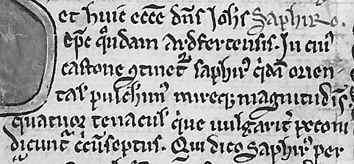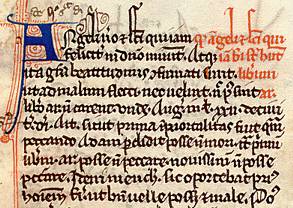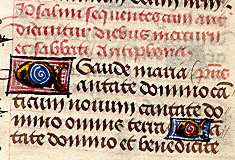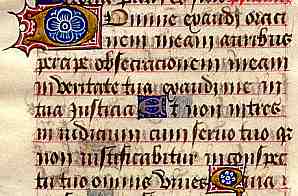





If you are looking at this page without frames, there is more information about medieval writing to be found by going to the home page (framed) or the site map (no frames).
| The History of Gothic Book Hands (4) | |||||
| Some changes to accommodate large amounts of written text involved changes of style more than the development of new scripts. | |||||
 |
Enlarged grab from a mid 13th century work of Matthew Paris, the Liber addimentorum (British Library, Cotton Nero D1, f.146v), by permission of the British Library. | ||||
| The sample above, which has been very much enlarged so that you can see the letter forms, is from an autograph manuscript of Matthew Paris, the famous 13th century chronicler from the monastery of St Albans. No doubt as a monastic scribe he was well versed in the formal Gothic textura, but this small and busy, crowded text has made use of some borrowings from the chancery scripts of the day. While the bodies of the letters are small, the ascenders and descenders are relatively longer than in standard textura. Some ascenders are curled and split, while desenders can have extravagant curls. The letter a is the open, single chambered form, with the upper curl raised. It is not a cursive script, as the letters are formed individually, but it has borrowed some mannerisms from the cursive style. This may provide a more flowing style of writing for the scribe, and increased legibility for the reader. | |||||
| This example is somewhat similar, although the letter forms are closer to standard textura, but the tall, decorative ascenders on the top line are a borrowing from document hand. The great peculiarity of this as a text for reading is the incredible use of abbreviation, to the point where you would nearly need to know the text off by heart to be able to read it. This example illustrates the problems of textura in a dense text for study. |  |
||||
| Section of a page from a 13th or14th century copy of the Sentences of Peter Lombard, from a private collection. | |||||
| In different areas, scribes took characteristics from the chancery and business hands of the region and incorporated them into new formal cursive book hands. By the 14th and 15th centuries, writing was a much more common skill among the laity, some of whom practiced it because it was a gentlemanly accomplishment (and yes, despite the fact that female scribes are known, they were a bit sexist about it), and others because it was part of their job. The world of work was becoming more literate. | |||||
 |
This is a section from a mid 15th century manuscript of the Conquêtes de Charlemagne (Brussels, Bibliothèque Royale, MS 9066-68, Vol.1, f.138b). (From New Palaeographical Society 1904) | ||||
| In France the Secretary hand of the chancery influenced book hand, producing a hybrid which paleographers insist on calling Bâtarde, among other things. Tall letters are long and tapering and the bases of letters tend to lack blocky feet. There are some characteristic letter forms, such as a tight double closed curly s at the ends of words, and open descender on g and a simple single chambered a. At its best, it can look very elegant and French, while being very legible. | |||||
| However, sometimes it may look very pretty, but the tapering points at the ends of all the letters can make the minims even harder to resolve than in standard textura, even in this elegant example from a very small book of hours. |  |
||||
| Segment of a leaf from a late 15th century Flemish book ofhours, from a private collection. | |||||
 |
Fragment of a German notarial document, possibly 15th century, from a private collection. | ||||
| The German style of formal notarial script seems to have remained rather more Gothic in appearance, with angular letters and ascenders with closed angular loops, even while written in the cursive mode. | |||||
| This example, which would no doubt be defined as Bâtarde and is probably French, seems to owe some characteristics to the style of notarial script above, but then handwriting was never really confined by national boundaries. I personally find the example at right over fussy and fiddly and not especially legible. |  |
||||
| Segment of a leaf from a 15th century French book of hours, probably from Limoges, from a private collection. | |||||
| In England, the style of writing produced by the chancery underwent several changes, although they were basically stylistic variants of the same underlying set of letter forms. The scribes of books followed these stylistic variants in the production of cursive book hands, until eventually there was no real difference between some book and document hands. Paleographers who study documents may call this chancery bastarda, while those who study books give it a longer title, but bastarda gets in there somewhere. It is actually a testament to the legitimate contribution made by the English royal chancery to English as a written language and the mode in which it was written. | |||||
|
|
|||||
|
If you are looking at this page without frames, there is more information about medieval writing to be found by going to the home page (framed) or the site map (no frames). |
|||||